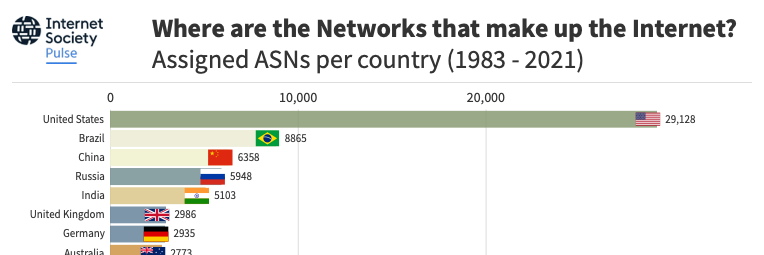The Internet is a network of networks. But where are these networks? We can get some insight by using the location of the organization that holds the registration for the allocated Autonomous System Number (ASN) assigned to the network as a proxy for the location of that network. All Internet networks must be assigned an ASN in order for them to be connected to the routing fabric of the Internet. ASN registration records are public and maintained by the Regional Internet Registries.
Check out our animated timeline of ASN allocations below to see how the countries that are home to the networks that make up the Internet have evolved over time.
You won’t be surprised to learn that since the Internet’s origins the United States has been, and remains, home to the largest number of Internet connected networks. Today, of the roughly 109,000 assigned networks, over 29,000 (27%) are assigned to organizations located in the US.
Before 1992, according to the registration data, there were very few countries with jurisdiction over Internet connected networks. This is partly a feature of the data source – very early IP address allocations to other countries were recorded, but the associated ASNs were apparently not recorded until later or assigned to the US.
Around 1992/1993 the European academic research networking community started getting online in earnest and the EU took the number two spot from Canada and remained there until around the turn of the millennium.

1992 is also when many other countries started getting connected to the Internet and this is when we first see the diversity of the list of countries with assigned networks start to grow rapidly.
Around 2001, South Korea and then Japan take over the number two position from the EU before the extremely rapid growth of Internet networking in Russia comes to dominate (excluding the US) for around five years.
Interestingly, this growth spurt isn’t confined to Russia, but applies to Eastern Europe more generally: for a time around 2010-11 Poland and Ukraine follow Russia.
Since Russia’s emergence as a major home for Internet networks, growth has been dominated by some of the other BRICs, namely Brazil, India, and China.
China’s recent rapid expansion is interesting as there has been speculation that these additional network number assignments are required for improving the scalability and granularity of the Internet censorship regime in effect in that country. The huge and rapid growth in assignments to Brazilian network operators is a testament to the hard work of NIC.br who have provided extensive training on network creation, lowered administrative barriers to obtaining network number assignments and encouraged network interconnection at their Internet exchange points (IXPs).

Using the record of ASN assignments to perform this analysis provides us with only a very partial view of Internet history. For example it takes no account of whether these networks are actually visible in the routing system of today’s Internet (around 30% of assigned ASNs are not visible, for various reasons, including that they are used for private network deployments and not connected to the public Internet). Nevertheless, looking at the country codes of the organizations to which ASNs are assigned is one way of thinking about the question ‘where is the Internet?’.
In future posts I plan to present some other perspectives that help to answer that question and hopefully provide some useful insights into how the Internet is evolving.
Photo by Alina Grubnyak on Unsplash.


